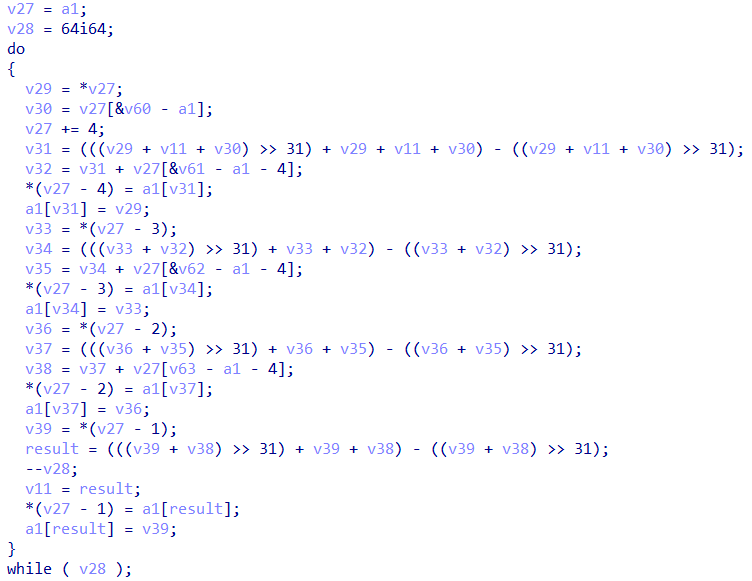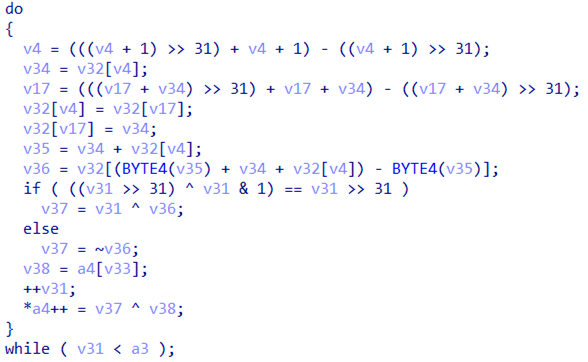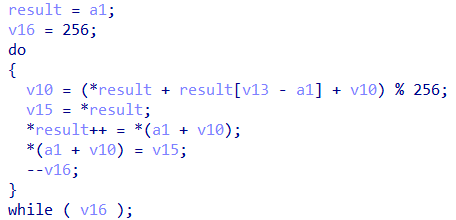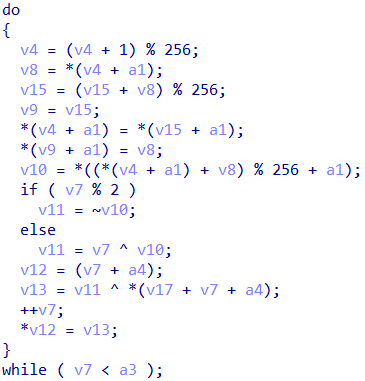Our blog entry provides an in-depth analysis of Earth Hundun’s Waterbear and Deuterbear malware.
Summary
- Earth Hundun is a cyberespionage-motivated threat actor that has been active for several years in the Asia-Pacific region, targeting the technology and government sectors.
- The group has been known for employing several tools and techniques, including Waterbear, a malware entity that has had over 10 versions since 2009.
- Waterbear is known for its complexity, as it uses a number of evasion mechanisms to minimize the chance of detection and analysis. Succeeding versions have added enhancements that make it even more troublesome to deal with.
- In 2022, Earth Hundun began using the latest version of Waterbear — also known as Deuterbear — which has several changes, including anti-memory scanning and decryption routines, that make us consider it a different malware entity from the original Waterbear.
- Our blog entry provides an in-depth analysis of these two malware types in Earth Hundun’s bag of tools.
Introduction
We recently observed a surge in cyberattacks targeting a number of organizations in various sectors such as technology, research, and government. These attacks involve a malware family known as Waterbear that is linked to the cyberespionage group Earth Hundun (also known as BlackTech), a threat actor that focuses on gathering intelligence from technology and government organizations, particularly in the Asia-Pacific region.
Among the group’s arsenal of weapons, the Waterbear backdoor is one of the most complex, with a wide array of anti-debug, anti-sandbox, and general antivirus-hindering techniques. Moreover, the frequent updates from its developers have led to even more evasion tactics, including enhancements of its loader, downloader, and communication protocol. This report will delve into the latest techniques Earth Hundun has implemented with Waterbear and provide an analysis of its latest iteration, Deuterbear.
Waterbear details
Waterbear has had over 10 versions since 2009, with the version number directly visible in the configuration. Despite available solutions for older versions, its operators typically persist in enhancing infection flows until a successful compromise. Therefore, it is common to find multiple versions coexisting within the same timeframe and even within the environments of the same victims.
Interestingly, some Waterbear downloaders have been seen using command-and-control (C&C) servers with internal IP addresses (for instance, the downloader with hash 6b9a14d4d9230e038ffd9e1f5fd0d3065ff0a78b52ab338644462864740c2241 uses the internal IP 192.168.11[.]2 as its C&C server).
This suggests that the attackers might have in-depth knowledge of their victims’ networks, employing multilayered jump servers to evade detection. Such tactics underscore the sophisticated nature of these attacks, which are designed to stealthily maintain presence and control within compromised environments.
Attack chain and TTPs of Waterbear

For the launcher, Waterbear uses a legitimate executable to load its custom DLL file. In some cases, its operators patched the legitimate executable to modify the import table. This includes adding the DLL with the same file name at ordinal 0, enabling a smooth launch of the loader via DLL sideloading. This strategy allows Earth Hundun to run its custom DLL loader and avoid detection.

Loader
Based on the diagram shown in Figure 1, there are two decryption routines used by Waterbear to decrypt the encrypted downloader.
We observed that recent Waterbear loader routines commonly use the same custom salted RC4 decryption, accompanied by a similar obfuscation pattern, to decrypt the downloader. This approach is consistent across downloader versions 0.13, 0.16, and 0.24. In contrast, earlier versions of the Waterbear loader were barely obfuscated, if at all.


In some cases, Waterbear loaders routinely place the encrypted downloader in the registry in advance, with the downloader being decryptable only on the infected machine since it uses the CryptUnprotectData API. This method is limited by the requirement that it must operate on the infected machine. However, it can prevent the victim from realizing that they are being attacked, while also hindering incident responders during investigation.
Downloader
Earth Hundun has been gradually refining its technique to bypass antivirus software adding a large amount of padding with 0x00 around the beginning and end to avoid detection. After decryption, the loader executes the shellcode directly and checks the debugger mode, initiating the Waterbear downloader.
- Decrypts the function before using it and encrypts it again after use
- After recovering the function address, they quickly move it to another place in memory and mess-up the original address.
For more detailed information, please refer to our previous report, specifically the section titled “Anti-memory scanning of shellcode payload.”
The configuration outlined in the previously mentioned report contains the information required for proper execution and communication with C&C server.
| Data offset | Data size | Data content |
|---|---|---|
| 0x00 | 0x04 | Encryption/Decryption key for the functions |
| 0x10 | 0x04 | Remote access trojan (RAT) infection mark, which is also used for sleep time. |
| 0x14 | 0x10 | Version (such as 0.13, 0.16, 0.24, and so on) |
| 0x24 | 0x0C | Mutex (not use for now) |
| 0x34 | 0x78 | C&C server address, which is XOR-encrypted with the key 0xFF; has each address with a maximum length of 0x28 and supports up to 3. If the downloader is intended to listen in on a specific port, this section will be filled with 0x00. |
| 0xAC | 0x02 | Port number (might contain multiple numbers) |
| 0xD8 | 0x10 | traffic KEY_1, RC4 key of first traffic sent from victim |
| 0xE8 | 0x10 | traffic KEY_2, unique ID to identify victim |
| 0xF8 | 0x10 | traffic KEY_RANDOM (randomly generated by the downloader and the RC4 key of encrypted RAT sent from the C&C server) |
| 0x108 | 0xC8 | List of function addresses (for example, 0x8 * 25 functions) |
| 0x1D0 | 0x64 | List of function lengths (for example, 0x4 * 25 functions) |
| 0x234 | 0x124 | List of API addresses |
| 0x358 | 0x90 | List of encrypted API hash |
| 0x3E8 | 0x78 | List of library names |
Table 1. The configuration structure of Waterbear downloader

For the network request, the downloader will set up the custom connection to deliver the next stage RAT as follows:

| Index | Direction | Encryption | Key |
|---|---|---|---|
| 1 | Victim -> C&C | Salted RC4 (10000 times) | KEY_1 |
| 2 | C&C -> Victim | Salted RC4 | KEY_RANDOM XOR reversed (KEY_1) |
| 3 | C&C -> Victim | Salted RC4 | KEY_RANDOM |
| 4 | C&C -> Victim | Salted RC4 | KEY_RANDOM |
Table 2. Basic information about network traffic to download the Waterbear RAT
All of the packets have a 10-byte header with which to describe the information of data (keeping the same format as described in a report published by Palo Alto. However, the signature has been obfuscated over time by the threat actors to evade detection. The analysis of the latest protocol is shown here:
Send KEY_RANDOM
The downloader randomly generates the 16-byte key, KEY_RANDOM, and sends the packet to the C&C server with the format:
| Offset | Size | Type | Content |
|---|---|---|---|
| 0x00 | 0x10 | Header | The 1st, 4th, and 6th are generated randomly and applied to encrypt other bytes in the header. 2nd: 0x40 XOR 6th byte 3rd: 0x1F XOR 1st byte 5th: 0x03 XOR 4th byte XOR ((1st byte >> 4) AND (6th byte << 4)) 7th: size_of_data XOR 1st byte 8th: (size_of_data >> 8) XOR 6th byte 9th: (size_of_data >> 16) XOR 4th byte 10th: (size_of_data >> 24) XOR (4th byte << 4) AND (6th byte >> 4) |
| 0x10 | 0x20 | Data | 0x00 – 0x10: <KEY_RANDOM> XOR “abcdefghijklmnox00” 0x10 – 0x20: <KEY_RANDOM> XOR <KEY_2> |
Table 3. Packet format for sending KEY_RANDOM.
The header contains the command code 0x40 0x1F, and the size of the data in the last four bytes by little-endian, but this variant’s obfuscation method is more complex than the previous version. The C&C server will perform the reversed calculation to decrypt the header and data while the KEY_RANDOM will be applied to the key of the salted RC4 in the next packets. The KEY_2 is the unique ID to check the target.
C&C Verification
C&C server sends the packet to victim for verification with the format:
| Offset | Size | Type | Content |
|---|---|---|---|
| 0x00 | 0x10 | Header | ?? 40 1F ?? ?? ?? ?? ?? ?? ?? (The last 4 bytes are the size of the data with little-endian) |
| 0x10 | 0x20 | Data | The data contains the KEY_1, with the offset of KEY_1 being ((1st byte XOR 2nd byte) + 2) |
Table 4. Packet format for C&C verification.
Get RAT Size
C&C server sends the packet for RAT size with the format:
| Offset | Size | Type | Content |
|---|---|---|---|
| 0x00 | 0x10 | Header | ?? 43 1F ?? 00 ?? 04 00 00 00 |
| 0x10 | 0x04 | Data | The size of the RAT with little-endian. |
Table 5. Packet format for getting the RAT size
Download RAT
C&C server sends the packet for RAT with the format:
| Offset | Size | Type | Content |
|---|---|---|---|
| 0x00 | 0x10 | Header | ?? 43 1F ?? 01 ?? ?? ?? ?? ?? (The last 4 bytes are size of data with little-endian) |
| 0x10 | Not Fixed | Data | The segment of next-stage RAT. |
Table 6. Packet format for getting the RAT
This step repeatedly receives the packet from the C&C server until the whole RAT is delivered.
RAT command
Since TeamT5’s article in 2020 discussing Waterbear’s functions, there have been more of them that have been implemented, with the latest version shown in this table:
| Command code (decimal) | Capability |
|---|---|
| 2 | Enumerate disk drives |
| 3 | List files |
| 4 | Upload file to C&C server |
| 5 | Download file from C&C server |
| 6 | Rename file |
| 7 | Create folder |
| 8 | Delete file |
| 10 | Execute file |
| 11 | Move file |
| 12 | Disguise meta data of file |
| 13 | File operation |
| 806 | Get system language, system time and Windows installation date |
| 807 | Enumerate Windows |
| 809 | Hide Windows |
| 810 | Show Windows |
| 811 | Close Windows |
| 812 | Minimize Windows |
| 813 | Maximize Windows |
| 815 | Screenshot |
| 816 | Set screenshot event signaled |
| 817 | Remote desktop |
| 818 | Enumerate process |
| 819 | Terminate process |
| 821 | Suspend process with pID |
| 822 | Resume process with pID |
| 823 | Get process module infomation |
| 824 | Get process module info (for file or object using the authenticode policy provider) |
| 825 | Get extended TCP table |
| 826 | SetTcpEntry Set state of the TCP connection with MIB_TCP_STATE_DELETE_TCB |
| 827 | Enumerate services |
| 828 – 832 | Manipulate service |
| 833 | Get C&C in downloader config |
| 834 | Set C&C in downloader config |
| 1006 | Start remote shell |
| 1007 | Exit remote shell |
| 1008 | Get PID of remote shell |
| 1010 | Download DLL and execute the export function “Start” |
| 1300 | Unknown |
| 2011 | Enumerate Registry |
| 2012 | Enumerate registry value |
| 2013 | Create registry key |
| 2014 | Set registry value |
| 2015 | Delete registry key |
| 2016 | Delete registry value |
| 8001 | Get current window |
| 8004 | Set the infection mark in registry HKCUConsoleQuickEdit |
| 8005 | Terminate connection and RAT process |
| 9010 | Update C&C IP address |
| 9011 -9018 | Manipulate socket |
Table 7. List of RAT command and corresponding functionalities.
For more details about Waterbear’s past activities, please refer to our 2019 report.
Deuterbear details
The Deuterbear downloader, the latest Waterbear downloader, has been active since 2022 based on our telemetry. Because of significant updates in the decryption flow and configuration structure, we classify this variant as a distinct malware entity separate from the original Waterbear downloader category.
Attack chain and TTPs of Deuterbear

Loader
The decryption flow is limited on the victim’s side due to the API (CryptUnprotectData) and the need for more parameters, which are defined by the threat actor:
- Query password from registry (HKLM|HKCU|HKCR)SOFTWAREClassesCLSID{xxxxxxxx-xxxx-xxxx-xxxx-xxxxxxxxxx} with key ‘AppID’
- Query path of encrypted downloader from registry (HKLM|HKCU|HKCR) SOFTWAREClassesCLSID{xxxxxxxx-xxxx-xxxx-xxxx-xxxxxxxxxx}InprocServer32
- Downloader decryption
a. XOR with password from offset 16~999
b. CryptUnprotectData without password
c. XOR with password from offset 0~999
d. CryptUnprotectData with password
Note that the CLSID value is unique and defined during malware installation.
Downloader
The Deuterbear downloader enables HTTPS tunnel to protect the network traffic and implements the following obfuscation methods for anti-analysis:
- Breaking the function using jmp
- Checking debugger mode by process time
- Checking sandbox environment by API, Sleep, which is normal operation
- Checking execution in specific time, like 9~10 o’clock
- Implementing anti-memory scanning
Anti-memory scanning, which is inherited from the Waterbear downloader, encrypts all function blocks (except for the function involving decode routine) with a fixed key defined in configuration. However, the Deuterbear downloader executes the desired function in new virtual memory, and not in the local address that stores all the encrypted function blocks.


| Data offset | Data size | Data content |
|---|---|---|
| 0x00 | 0x04 | Signature (00 00 01 00) |
| 0x04 | 0x10 | Key (Only for C&C decryption) |
| 0x14 | 0x04 | Retry connection |
| 0x18 | 0x20 | Signature sends to the C&C server, requesting the next-stage RAT |
| 0x3A | 0x01 | Execution time lower bound in the morning (for example, 9 a.m.) |
| 0x3B | 0x01 | Execution time upper bound in the morning (for example, 11 a.m.) |
| 0x3C | 0x01 | Execution time lower bound in the afternoon (for example, 3 p.m.) |
| 0x3D | 0x01 | Execution time upper bound in the afternoon (for example, 5 p.m.) |
| 0x3E | 0x20 | Key for encrypted data and encrypted function |
| 0x5F | 0x01 | (Size of encrypted C&C server) – 3 |
| 0x60 | not fix | Encrypted C&C server +0: Flag for IP/Domain +1: Port number +3: C&C server |
| 0x1EA | 0x198 | List of function address (for example, 0x8 * 51 functions) |
| 0x382 | 0x66 | List of function length (for example, 0x2 * 51 functions) |
| 0x3E8 | 0x1A0 | List of API address |
| 0x588 | 0xB8 | List of encrypted API hash |
| 0x640 | 0x4D | List of encrypted library name |
Table 8. The configuration structure of the Deuterbear downloader


| Index | Direction | Encryption | Key |
|---|---|---|---|
| 1 | Victim -> C&C | N/A | N/A |
| 2 | C&C -> Victim | RSA | CSP_KEY |
| 3 | C&C -> Victim | Salted RC4 | RC4_KEY_2 (from index 2) |
| 4 | Victim -> C&C | Salted RC4 | RC4_KEY_1 (from index 2) |
| 5 | C&C -> Victim | Salted RC4 | RC4_KEY_2 |
| 6 | C&C -> Victim | Salted RC4 | RC4_KEY_2 |
Table 9. Basic information on traffic to download Deuterbear RAT
Deuterbear uses only 5 bytes in the header to describe the data information, with the general format being the following:
| Offset | Size | Content |
|---|---|---|
| 0x00 | 0x01 | Possibly the type of packet |
| 0x01 | 0x02 | Command code (Like 40 1F in the packet of Waterbear downloader) |
| 0x03 | 0x02 | Size of data |
Table 10. Header format of the Deuterbear packet
Send RSA public key
The downloader applies Microsoft CryptoAPI to generate an RSA public/private key, sending the public key to the C&C server for RSA encryption during the next communication.
The packet format is as follows:
| Offset | Size | Type | Content |
|---|---|---|---|
| 0x00 | 0x05 | Header | 01 CD 03 ?? ?? (The last 2 bytes are size of data with little-endian) |
| 0x05 | 0x114 | Data | RSA public key BLOBs for packet encryption in the next step. |
Table 11. Packet format for sending the RSA public key
Send RC4 Key
The C&C server prepares two keys for RC4 encryption, RC4_KEY_1 and RC4_KEY_2. The former is applied to encrypt the traffic from the victim to the C&C server, and the latter is for the direction from the C&C server to the victim. The keys are then encrypted by RSA public generated from the victim side and sent to the victim with the following packer format:
| Offset | Size | Type | Content |
|---|---|---|---|
| 0x00 | 0x05 | Header | ?? CD 03 ?? ?? (The last 2 bytes are size of data with little-endian) |
| 0x05 | 0x20 | Data | 0x05: RC4_KEY_1 0x15: RC4_KEY_2 |
Table 12. Packet format for sending RC4 key
RC4 verification
The victim side verifies whether the RC4 decryption is working by checking the decrypted data, which is the RSA public key.
| Offset | Size | Type | Content |
|---|---|---|---|
| 0x00 | 0x05 | Header | ?? ?? ?? ?? ?? (The last 2 bytes are size of data with little-endian) |
| 0x05 | 0x114 | Data | RSA public key BLOBs generated from victim. |
Table 13. Packet format for RC4 verification
Send download request
The victim side encrypts the download signature, which is located at configuration [0x18:0x38] and sends it to the C&C server to request the next-stage shellcode.
| Offset | Size | Type | Content |
|---|---|---|---|
| 0x00 | 0x05 | Header | 00 CD 03 20 00 (The last 2 bytes are size of data with little-endian) |
| 0x05 | 0x20 | Data | The download signatures |
Table 14. Packet format about sending download command to C&C
Get RAT Size
The C&C server sends the packet for the RAT size with the following format:
| Offset | Size | Type | Content |
|---|---|---|---|
| 0x00 | 0x05 | Header | 02 D0 03 04 00 |
| 0x05 | 0x04 | Data | This size of RAT with little-endian |
Table 15. Packet format for retrieving the RAT size
Download RAT
The C&C server sends the packet for the RAT with the following format:
| Offset | Size | Type | Content |
|---|---|---|---|
| 0x00 | 0x05 | Header | 01 D0 03 ?? ?? (The last 2 bytes are size of data with little-endian) |
| 0x05 | Not fixed | Data | RSA public key for packet encryption from C&C to victim |
Table 16. Packet format for downloading the RAT
This step repeatedly receives the packet from the C&C server until the whole RAT is delivered. The received Deuterbear RAT is in a shellcode format, unlike the original Waterbear downloader that loads the PE file for the next-stage RAT.
Comparison
Table 17 shows the difference between the Deuterbear downloader and Waterbear downloader:
| Properties | Deuterbear downloader | Waterbear downloader |
|---|---|---|
| Executable time | Limited | Any time |
| Anti-Memory scanning | Encrypt/Decrypt function in new virtual memory | Encrypt/Decrypt function in local address |
| Encrypted downloader path | Registry | File/Registry |
| Encrypted downloader decryption | CyprtUnprotectData | Salted RC4 or CyprtUnprotectData |
| C&C string decryption | XOR with 16-bytes key | XOR with 0xFF |
| C&C communication | HTTPS | HTTP |
| Size of packet header | 5 | 10 |
| Magic bytes in header | CD 03 | 40 1F |
| D0 03 | 43 1F | |
| RC4 key in downloading traffic | Generated by the C&C server | Generated by the victim |
| Format of downloaded RAT | Shellcode | PE file |
Table 17. Differences between the Deuterbear downloader and Waterbear downloader
Conclusion
Since 2009, Earth Hundun has continuously evolved and refined the Waterbear backdoor, as well as its many variants and branches. Despite available solutions, the enhancements in infection methods and anti-analysis mechanisms have led to the most advanced variant so far — Deuterbear. The Deuterbear downloader employs HTTPS encryption for network traffic protection and implements various updates in malware execution, such as altering the function decryption, checking for debuggers or sandboxes, and modifying traffic protocols.
According to our telemetry, Earth Hundun has continued to infiltrate the Asia-Pacific region, and the ongoing evolution of Waterbear and Deuterbear presents formidable challenges to organizational defense efforts. As such, Trend Micro remains committed to further enhancing our monitoring and detection methods accordingly.
MITRE ATT&CK
| Tactic | Technique | ID | Description |
|---|---|---|---|
| Execution | Shared Modules | T1129 | Dynamically loads the DLLs through the shellcode |
| Native API | T1106 | Dynamically loads the APIs through the shellcode | |
| Persistence | Hijack Execution Flow: DLL Side-Loading | T1574.002 | Uses modified legitimate executable to load the malicious DLL |
| Boot or Logon Autostart Execution: Print Processors | T1547.012 | Abuses print processors to run malicious DLLs during system | |
| Defense Evasion | Obfuscated Files or Information: Binary Padding | T1027.001 | Padding huge 0x00 in encrypted downloader |
| Masquerading: Match Legitimate Name or Location | T1036.005 | Makes the patched executable that appears legitimate or benign to users and/or security tools | |
| Deobfuscate/Decode Files or Information | T1140 | Uses RC4 or CryptUnprotectData to decrypt encrypted downloader | |
| Execution Guardrails | T1480 | Targets specific path/registry in the victim’s environment | |
| Virtualization/Sandbox Evasion: Time Based Evasion | T1497.003 | Downloaders check sandbox by API, Sleep, whether normal operation. | |
| Debugger Evasion | T1622 | Downloaders check debugger mode by process time. | |
| Discovery | File and Directory Discovery | T1083 | RAT searches files and directories or in specific locations. |
| System Network Configuration Discovery: Internet Connection Discovery | T1016.001 | Downloaders check for internet connectivity on compromised systems. | |
| System Network Connections Discovery | T1049 | Waterbear RAT lists network connections to or from the compromised system they are currently accessing or from remote systems by querying for information over the network. | |
| Process Discovery | T1057 | Waterbear RAT searches specific process. | |
| System Information Discovery | T1082 | Waterbear RAT gets detailed information about the operating system and hardware, including version, username, and architecture. | |
| Query Registry | T1012 | Queries data from registry to decrypt downloader | |
| Collection | Data from Local System | T1005 | Collects basic information of victim |
| Exfiltration | Exfiltration Over Command-and-Control Channel | T1041 | Sends collected data to C&C |
| Command and Control | Application Layer Protocol: Web Protocols | T1071.001 | Downloaders communicate with C&C by HTTP/HTTPS |
| Encrypted Channel | T1573 | Employs a RC4/RSA to conceal command and control traffic | |
| Data Encoding: Non-Standard Encoding | T1132.002 | Encodes traffic with a non-standard RC4 to make the content of traffic more difficult to detect |
Indicators of Compromise
The indicators of compromise for this entry can be found here.
We’d like to thank Trend’s Dove Chiu and Shih-hao Weng for additional intelligence.
Source: Original Post




